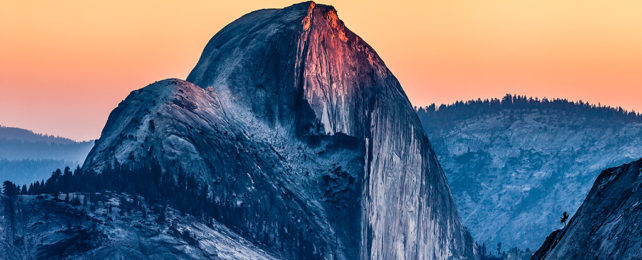Soaring thousands of feet above the meandering trails of the Yosemite Valley floor, monoliths with names like El Capitan and Sentinel Rock stand watch like mythological titans of old.
Just how long they've dominated the landscape isn't clear, with previous estimates on their emergence ranging anywhere from tens of millions to just 15 million years ago.
A new attempt to clarify the timing of Yosemite Valley's evolution has found previous measures may have been off the mark, with its stunning granite skyline thought to have emerged over the past 10 million years.
What's more, according to a research team led by geologists from the University of California, Berkeley, the majority of the sculpting could have even taken place as recently as the past 5 million years.
"This upland surface that people are familiar with from parts of the Tioga Road and Tuolumne Meadows – that's a very old landscape," says UC Berkeley glaciologist Kurt Cuffey.
"The question is: What about the deep canyon? Is that also very old, or is it relatively young? And what we found in our study, our big contribution, is that it's fairly young. The best guess for the timing is in the last 3 to 4 million years, but maybe as far back as 10 million years for the start of the rapid incision."
Yosemite National Park sits among the jagged peaks of the Sierra Nevada – a mountain range created from a chain of volcanos generated by the clashing of continental plates around 100 million years ago.
Over time, the elements have continued to polish the granite and strip away the limestone and shale to create natural features famed around the world for their raw beauty, while forces beneath the surface have continued to thrust the bedrock skyward.
Yosemite Valley itself is home to a handful of monoliths that stand out for their imposing facades – near-vertical rock faces that attract photographers, naturalists, and tourists … not to mention rock climbers willing to brave life and limb to scale them.
While the rocks themselves are easy enough to analyze for clues on aging, the sculpting of their flanks is another story altogether.
"We know that the Sierra was a high mountain range 100 million years ago, when the granite was forming at depth. It was a chain of volcanoes that might have looked a bit like the Andes Mountains in South America," says Yosemite National Park geologist Greg Stock.
"The question really is whether the elevation has just been coming down through erosion since that time or whether it came down some and then was uplifted again more recently."
There are plenty of indications around the Sierra Nevada that both mechanisms are at work, steepening slopes and exposing sections of the range to increased weathering and erosion.
Extrapolating from these events, geologists presume similar phenomena could have been at work in Yosemite tens of millions of years ago.
To move beyond assumptions, the researchers employed a technique developed by senior author and UC Berkeley geochemist David Schuster; one based not on models of a shifting landscape, but evidence baked inside the minerals that make up the prominent rock formations.
Called helium-4/helium-3 thermochronometry, the method involves an assessment of helium-4 isotope, which slowly decays into helium-3 over time.
At temperatures above 30 °C (around 86 °F), this change sharply escalates, providing a means of approximating the rate of cooling of a distribution of rock samples.
Much like a thermometer can be used to judge how long a cake has been cooling out of the oven, these results can provide researchers with a clue on how long a sizable rock has been above the warmer parts of the crust.
Subjecting mineral samples from 16 sites in and around Yosemite Valley to thermochronometry, the researchers mapped a history of cooling across the sprawling expanse of igneous rock.
We might now imagine a river gradually etched a groove through the Sierra Nevada geology over the course of tens of millions of years, scratching out a path for what would eventually become a valley.
Roughly 5 million years ago, renewed activity beneath the crust tilted the range, speeding up the water's flow and deepening the ravine.
With the cooling of the climate in the past 2 to 3 million years, glaciers took their icy chisels to the valley floor and its rock walls, pushing back the boundaries and sculpting the familiar cliffs that dwarf us today.
Millions visit Yosemite every year, feeling awe in the presence of these monolithic giants. Now, those feelings of wonder might even grow stronger, knowing that in a single glance, they're seeing formations as old as the dinosaurs – and yet as recent as humanity's own emergence.
This research was published in the Geological Society of America Bulletin.
